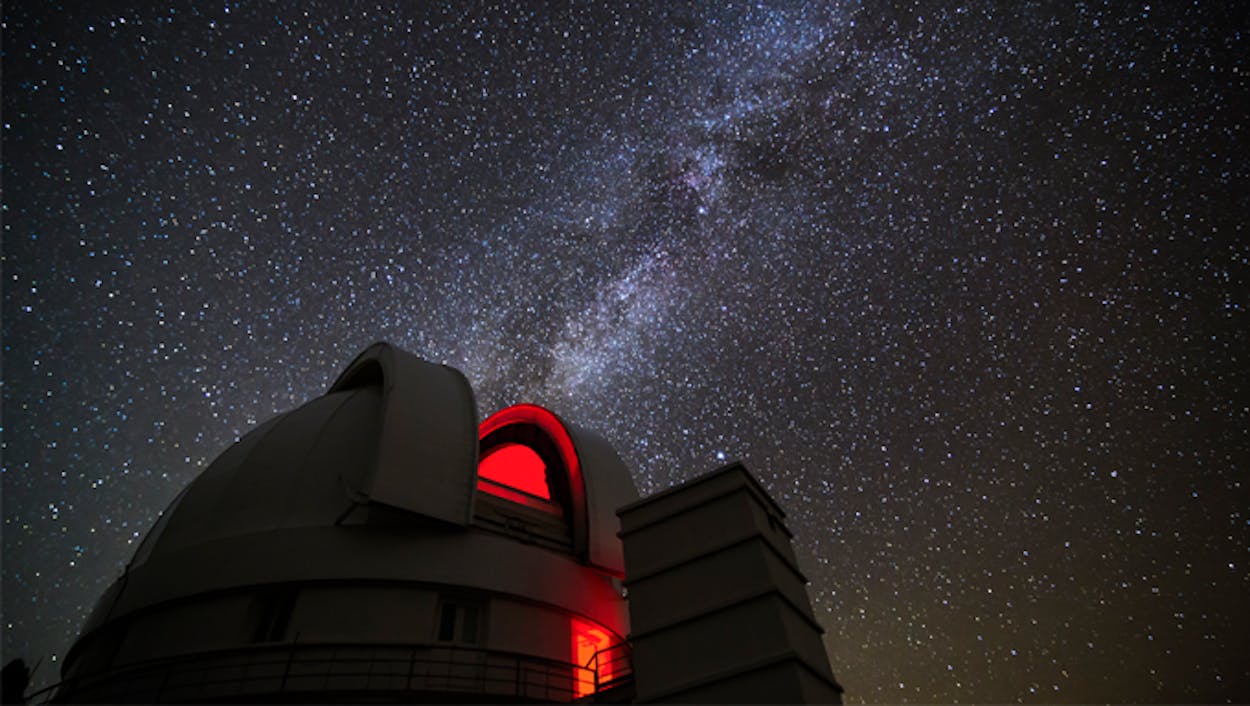Seventy-five years ago, on May 5, 1939, a group of the world’s preeminent astronomers trekked out to the Davis Mountains to attend the dedication of the McDonald Observatory’s first telescope, the second-largest in the world at the time, boasting an 82-inch, 4,200-pound Pyrex mirror cast from molten glass. A more dapper crew has probably never assembled among the succulents and scrub of West Texas: the 39 men—most wearing three-piece suits and clutching their felt fedoras—and one woman were photographed in front of the building housing the telescope. “The energy of the stars surpass all imagination,” Otto Struve, the Russian American astronomer who served as the observatory’s first director, told the group.
And what better place to study that energy than in West Texas. The area remains the darkest corner of the continental United States and features a latitude close to the equator, making the observatory an optimal astronomical research facility. Discoveries made there since the McDonald Observatory’s founding 75 years ago include the first evidence of water on Mars, a binary system of white dwarves that orbit each other every thirteen minutes, and the most massive black hole found to date, weighing as much as 17 billion suns.
The story of the observatory could have been a much unhappier one if it had been built at its first proposed location: outside of Austin, then a sleepy town of 60,000 and now the country’s fastest-growing city. Sites near Mount Bonnell and Jollyville Road were initially suggested, “but eventually saner minds ruled,” David Lambert, the observatory’s director, told me. “It was required that the telescope be built within the state of Texas, and the further west you go the better the weather becomes.” So the site near Fort Davis was chosen, and the area remains one of least-populated parts of the country. (Only 54,000 people live in the seven counties around the observatory, fewer than two per square mile.)
But now, for the first time in its lengthy history, the observatory is dealing with a threat to its pristine views. While urban encroachment is not a threat to the McDonald Observatory, the oil boom in the Eagle Ford Shale and the Permian Basin could be, if drilling operations are sloppily managed, with “poorly aimed floodlights” that point out haphazardly up in the air or toward the horizon. Satellite images of Texas from space show that large swaths of the map that were dark in 2010, before the boom picked up, are now covered with blobs of light. Bill Wren, a special assistant to the superintendent who has been with the observatory since 1990, has been spearheading the cause to keep the skies above and around the observatory dark. He has spoken to various industry groups in an effort to share how to reduce light pollution and glare, something that can be as simple as aiming lights toward the ground. “The places you can go to see a dark sky are going away and we’re trying to do what we can to hang on to this one,” Wren explained. The state legislature has helped as well, passing a bill in 2011 requiring new outdoor light fixtures in the seven counties around the observatory to be dark sky–friendly.
The enduring lure of the dark sky is why more than 68,000 visitors made the trek out to the McDonald Observatory in 2013. Sandy Wood, the voice of StarDate, the observatory’s two-minute astronomy radio program, says that she’s always impressed at the numbers of out-of-staters she sees when attending one of the observatory’s “Star Parties,” held thrice-weekly at the Frank N. Bash Visitors Center. “You have to intend to go there, it’s out of the way. I’m very proud to hear those voices when I go out there,” she told me. After almost 23 years of being the observatory’s most public ambassador through her voice, the place still feels almost magical to Wood. “When we travel out to the observatory and round that corner where the telescopes are visible, a chill still runs through my body,” she explained.
Meanwhile, research presses on and the future of the observatory seems bright—in the right ways. Currently, the focus of research has shifted toward investigating dark energy, a topic University of Texas physics professor and Nobel Laureate Steven Weinberg has said is “not only terribly important for astronomy, it’s the central problem for physics. It’s been the bone in our throat for a long time.” The recently departed billionaire Harold Simmons was intrigued by dark energy and donated $5 million to the University of Texas in 2006 and another $2.5 million in 2010 to help upgrade the Hobby-Eberly Telescope. By spring of 2015 upgrades to the telescope will be complete and it will begin creating a richly detailed, three-dimensional map of the universe stretching back 11 billion years in time. “We’ll be making precise measurements on the expansion rate of the universe as it was 11 billion years ago,” Lambert explained.
Keeping the skies dark around the observatory will help ensure that this research continues for years to come. “There’s just something about the dark nighttime sky that never ceases to thrill me,” Wren said. “We’re raising generations of people in and around our major population centers who have never seen a dark sky.”
Upcoming events marking the anniversary include can be found on the McDonald Observatory’s website.







